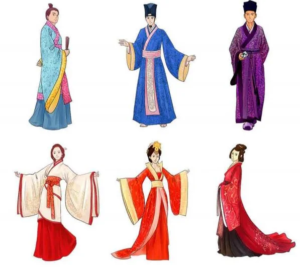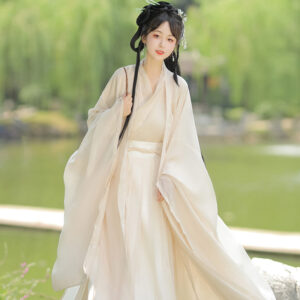
Overview of Predominant Colors in Qing Dynasty Hanfu

The color palette of Qing Dynasty Hanfu was rich and varied, with each hue carrying its own meaning and significance. The predominant colors included:
- Imperial Yellow: Symbolizing power and authority, this color was reserved for the emperor and his immediate family.
- Royal Blue: Often associated with nobility, royal blue was a favorite among high-ranking officials.
- Crimson Red: A color representing happiness and good fortune, red was commonly worn during celebrations and festivals.
- White: While often linked to mourning, white also represented purity and was used in specific ceremonial contexts.
- Green: Symbolizing prosperity and harmony, green was popular among commoners as well as nobility.
- Black: Representing stability and authority, black was often used in formal attire.
- Purple: Associated with wealth and luxury, purple was favored by the elite classes.
Table of Predominant Colors in Qing Dynasty Hanfu
| Color | Symbolism | Usage Context |
|---|---|---|
| Imperial Yellow | Power and authority | Worn by the emperor and family |
| Royal Blue | Nobility | Common among high-ranking officials |
| Crimson Red | Happiness and good fortune | Worn during celebrations |
| White | Purity (also mourning) | Used in specific ceremonies |
| Green | Prosperity and harmony | Popular among all classes |
| Black | Stability and authority | Used in formal attire |
| Purple | Wealth and luxury | Favored by the elite |
The Cultural Significance of Color
Colors played a crucial role in the social fabric of the Qing Dynasty. Each color not only had aesthetic appeal but also conveyed important social messages. Understanding these meanings provides insight into the culture of the time.
Imperial Yellow
Imperial yellow was perhaps the most significant color during the Qing Dynasty. It was exclusively reserved for the emperor, symbolizing his divine right to rule. This color represented not just authority but also a connection to heaven and earth, reinforcing the emperor’s status as a mediator between these realms.
- Historical Context: The use of imperial yellow can be traced back to earlier dynasties, but it reached its zenith during the Qing era.
- Cultural Impact: This exclusivity created a visual hierarchy within society, where colors indicated rank and privilege.
Royal Blue
Royal blue emerged as a color associated with nobility during the Qing period. It denoted high social standing and was often worn by officials during formal occasions.
- Historical Context: The popularity of royal blue can be linked to its vibrant appearance and its association with prestige.
- Cultural Impact: Wearing royal blue allowed individuals to visually assert their status within the rigid class structure of Qing society.
Crimson Red
Crimson red is synonymous with joy and celebration in Chinese culture. During the Qing Dynasty, this color was widely used during festivals, weddings, and other auspicious events.
- Historical Context: Red has been a symbol of happiness since ancient times, making it a favorite choice for celebratory attire.
- Cultural Impact: The prevalence of crimson red during festive occasions reinforced communal bonds through shared cultural expressions.
White
While white is typically associated with purity in many cultures, it also carries connotations of mourning in Chinese tradition. In the context of Qing Dynasty Hanfu, white garments were worn during funerals or memorial services.
- Historical Context: The duality of white as both pure and mournful reflects complex cultural beliefs about life and death.
- Cultural Impact: This duality allowed for nuanced expressions of emotion through clothing choices.
Green
Green symbolizes prosperity and harmony in Chinese culture. During the Qing Dynasty, it became popular among both commoners and nobility alike.
- Historical Context: The association between green and prosperity can be traced back to agricultural cycles.
- Cultural Impact: Wearing green attire represented an optimistic outlook on life, resonating with societal aspirations for growth.
Black
Black has historically been linked to stability and authority. In terms of clothing during the Qing era, black garments were often worn by officials or during formal ceremonies.
- Historical Context: Black’s association with power made it an ideal choice for those wishing to convey seriousness or gravitas.
- Cultural Impact: The use of black attire helped reinforce social hierarchies through visual cues.
Purple
Purple emerged as a color associated with wealth and luxury during the Qing Dynasty. It was favored by elites who wished to display their affluence without resorting to more ostentatious colors like gold or red.
- Historical Context: Purple dyes were rare and expensive to produce, making them a status symbol.
- Cultural Impact: Wearing purple allowed individuals to subtly communicate their wealth while adhering to societal norms around modesty.
Seasonal Variations in Color Usage
The colors worn during different seasons also reflected both practical considerations (like climate) and cultural traditions tied to seasonal festivals.
Spring
In spring, lighter colors such as green and pastel shades became predominant as they symbolized renewal and growth after winter’s dormancy.
- Cultural Significance: Spring festivals celebrated new beginnings, making vibrant colors appropriate for this season.
Summer
Summer saw a shift towards brighter hues like crimson red or royal blue due to their associations with warmth and vitality.
- Cultural Significance: Festivals such as Dragon Boat Festival featured bright colors that matched the season’s energy.
Autumn
Autumn brought about deeper tones like golds and browns that reflected nature’s transition into harvest time.
- Cultural Significance: These colors celebrated abundance while acknowledging change as leaves turned from green to gold.
Winter
Winter typically featured darker hues such as black or deep blue due to their associations with stability amidst harsh conditions.
- Cultural Significance: Formal attire often adopted these darker tones for ceremonial occasions reflecting solemnity during colder months.
Regional Variations in Color Preferences
Different regions within China exhibited unique preferences when it came to color choices for Hanfu during the Qing Dynasty.
Northern Regions
In northern areas where winters are long-lasting, warmer colors like deep reds or browns were favored for their ability to convey warmth both visually and emotionally.
Southern Regions
Conversely, southern regions known for their lush landscapes often embraced vibrant greens or floral patterns that echoed local flora, reflecting a connection between clothing choices and nature’s beauty.
Influence on Modern Fashion
The color palette established during the Qing Dynasty continues to influence modern fashion trends today. Designers draw inspiration from historical hues while incorporating them into contemporary styles that resonate with current aesthetics.
- Revival of Traditional Colors:
- Many modern designers have begun reviving traditional colors like imperial yellow or crimson red within their collections.
- Fusion Styles:
- Contemporary interpretations blend traditional hues with modern cuts or fabrics, creating unique hybrids that pay homage to history while appealing to today’s consumers.
- Cultural Events:
- Festivals celebrating Chinese culture often see participants donning traditional attire featuring these historical colors as a way of honoring heritage while showcasing personal style choices.
Conclusion
The predominant colors found within Qing Dynasty Hanfu reveal much about social hierarchies, cultural beliefs, seasonal changes, regional preferences, and even modern influences on fashion today. Each hue carries layers of meaning that reflect not just aesthetic choices but also deeper connections between clothing choices and identity throughout history. Understanding these nuances enriches our appreciation for this beautiful aspect of Chinese culture while highlighting its ongoing relevance across time
Share this post
Recent Posts


What were the key features of Hanfu during the Tang Dynasty?

How did Hanfu styles vary during different Chinese dynasties?

What accessories are typically worn with Hanfu?

How do you choose the right Hanfu for different seasons?

Newsletter
Popular Categories
Related Post
Sed aliquam, tortor et sodales malesuada, lorem leo luctus tellus, quis interdum eros nibh in nunc. Cras dignissim malesuada, lorem leo luctus

What are the winter hanfu called?

What were the key features of Hanfu during the Tang Dynasty?

How did Hanfu styles vary during different Chinese dynasties?


